
What is affiliate marketing?
Affiliate marketing is where you promote the product or service of another company in exchange for a commission on the sales you make. The commission is usually a percentage of the sale price, but sometimes it can be a fixed amount. You can earn commission by doing affiliate marketing
Why do affiliate marketing?
Here are two pieces of information to do affiliate marketing
1. Low-cost and take a very Low risk
Starting a business means incurring upfront costs for products, employees, equipment, rent, etc. This makes it risky and expensive. With affiliate marketing, all you need is a website. Even if it doesn’t work, you’ve only wasted time and a little money, and you’ve spent less and wasted less money
2. Very Easy to Scale
An exclusive dealer sells the product of only one company. As a bond marketer, you can promote products from many different companies and earn commissions from all of them. Due to this your earnings will be very high and you will take advantage of that earnings, hence it is called affiliate marketing.
Promoting items made by other individuals in return for a small commission on each sale is known as affiliate marketing. On many of the websites you visit, there are probably titles with the labels “affiliate links” or “sponsored posts”; alternatively, perhaps you have already taken the first step and registered with an affiliate network. This type of late marketing, which generates commission, is known as late marketing.

If you are new to affiliate marketing, let’s cover how it works.
Find an affiliate network or program first if you’re interested. See an overview of the program to see how it works, including categories of goods and services, payment methods and commissions offered
If you are interested, sign up and wait for the acceptance message. Then, start writing content and include unique links that the software has to offer. When any of your users use those links to make a purchase, you will get a nominal compensation in which you get a commission when you give the link to someone and that person buys that item by visiting that link. affiliate marketing
You have the option of working with certain businesses or affiliate networks, where you register and select the programs you are interested in. The programs are often separated into categories to facilitate choosing. Start marketing your affiliate links as soon as they’re approved on your website, in newsletters, on social media, and any place else you’re allowed to distribute them.
When you achieve the minimum payment level, the network pays you a payment. Payment options can vary, but checks, bank transfers, and PayPal are frequently used.
How To Start Affiliate Marketing? ( In 2022-23 Simple Steps )
Thousands of independent creators, entrepreneurs, and online publishers generate millions in revenue every month using affiliate marketing Millions per customer

So do hugely respected websites such as the New York Times, Forbes, and NerdWallet.
And according to Statista, spending on affiliate marketing programs by businesses will grow to $8.2 billion in the US this year. That’s up 76% in the last six years alone. But getting a slice of the billion-dollar pie isn’t as simple as slapping a few affiliate links on your blog.
Read More:- Ant-Man and the Wasp: Quantumania (2023) – heloBABA Marvel Movie
In fact, most beginners who try affiliate marketing fail to see the financial results they were promised by countless blogs and videos on the internet.
Read on to avoid common mistakes that hold beginners back, plus the most important affiliate marketing tips to help you become successful, sooner.
Here’s our guide to starting affiliate marketing the right way:
- Research your niche
- Choose the right platform
- Pick profitable affiliate programs
- Create optimized affiliate content
- Drive traffic to your affiliate site
- Build a simple affiliate marketing funnel
- Track and increase your affiliate sales
But first, a few affiliate marketing fundamentals you need to know.
What is affiliate marketing?
In the affiliate marketing business model, publishers and content producers receive compensation from brands in exchange for leads and sales. Similar to how a dealer is compensated with a commission for closed deals, this system operates.
You earn more money the more sales you generate. Cents on the dollar to many thousands of dollars per share are the possible ranges for connection commissions. When done correctly, affiliate marketing can increase your income or diversify the revenue of your current content business.
Here is a quick explanation of affiliate marketing in action:
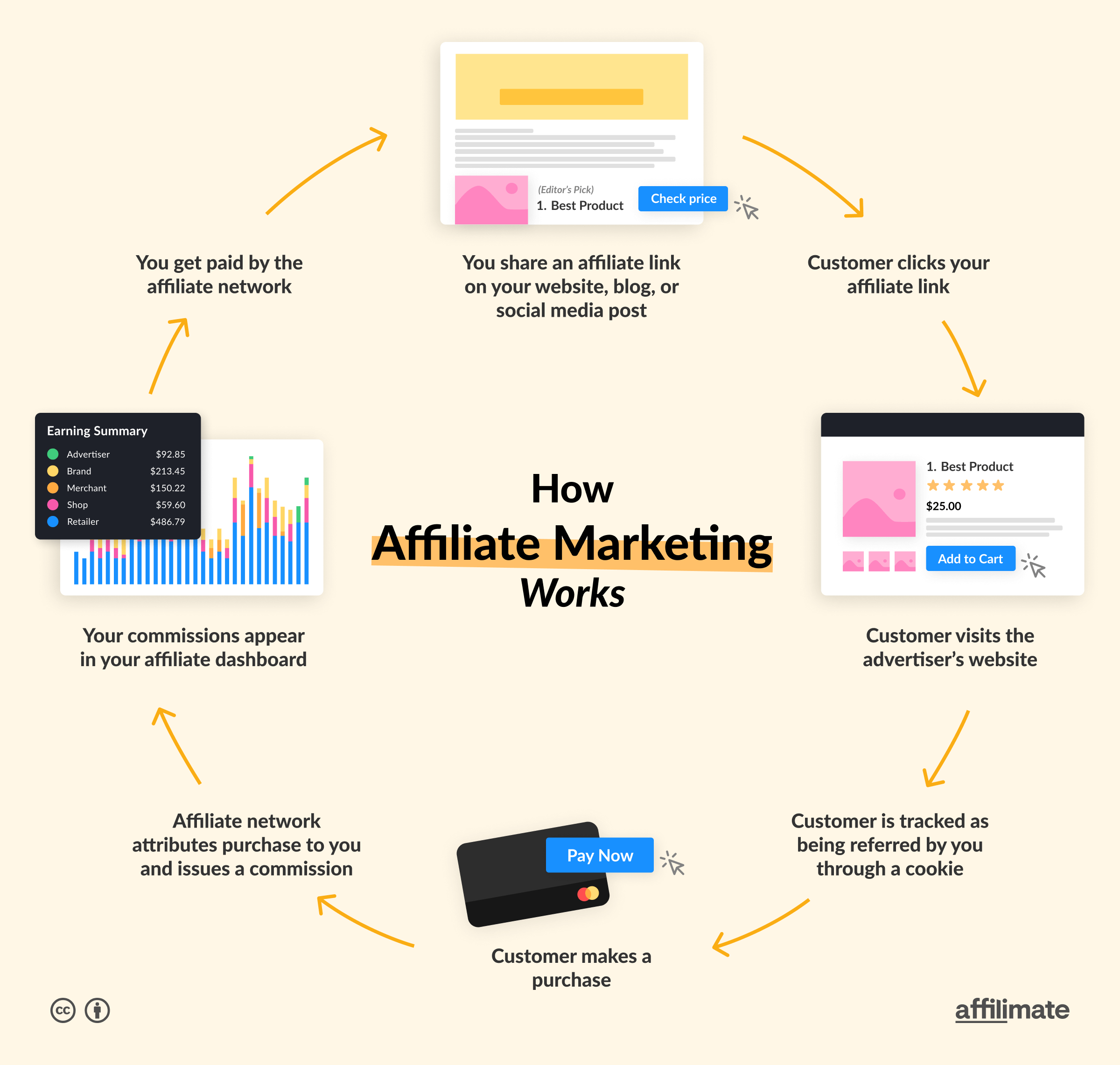
- You put a link to an affiliate site on your blog, website, or social media post.
- A client uses your affiliate link.
- A link is sent to the advertiser’s website from the client.
- Through a cookie, it is tracked that you recommended the consumer.
- The client purchases something.
- An affiliate network gives you credit for the transaction and pays you a commission.
- Payments are displayed on your affiliate dashboard.
- You are compensated by the affiliate network (!)
An affiliate marketer who is successful does not fit a certain description. Due to the fact that you are not in charge of a product’s or service’s distribution, affiliate marketing is minimal risk. Participants might range from individual business owners to groups at well-known news organisations and online publications. To succeed as an affiliate marketer, you don’t need a marketing degree or any other special training. Almost anybody can create affiliate money with the correct tools.
The capacity to engage an audience and draw in the correct sort of traffic is crucial for an affiliate’s success in today’s marketplace. You need to produce high-quality content that is conversion-optimized if you want to do this yourself. And creating affiliate links and comprehending them are the first steps.
What is an affiliate link?
The main method of Affiliate Marketing is through Affiliate Links. Affiliate links are trackable links that have a unique URL assigned specifically to you. They help advertisers know that you referred them to a specific customer, so they can pay you a commission if that customer makes a purchase.
Here is an example of the structure of a typical affiliate link:

The most crucial thing for a beginner to understand is that the customer who converts must use your specific affiliate link in order for you to receive a commission.
Then there is the method by which you receive commissions. There are primarily two methods for generating affiliate revenue:
- CPA (Cost Per Action): You earn every time someone from your audience completes an action. Depending on the program, the action could be making a purchase, starting a free trial, or filling out a form with contact information.
- CPC (Cost Per Click): You get paid for clicks the advertiser considers to be quality visitors, even if they don’t complete a specific action.
Some affiliate networks may even pay you for both leads and conversions. Different affiliate programs will provide various payment schemes. How to choose reputable affiliate programs will be covered later in this tutorial.
Read More:- Instagram Is Over The Atlantic Hacker News 2022
Here are a few more essential affiliate marketing phrases you should know while you’re here. You may choose affiliate programs with a high earning potential by using them as well:
- Cookies: Cookies are small files that are stored on a customer’s device when they click an affiliate link. They help businesses and affiliate networks remember that you referred the customer to them, so they can give you a commission later on.
- Cookie duration: Cookies typically have expiration dates. Affiliate links tend to have expiration dates between 15 to 30 days, but they can run for as little as 24 hours up to a year or more. Cookie duration matters to affiliate marketers because customers may come back to purchase days or weeks after a customer first clicks on an affiliate link.
- Affiliate networks: Brands typically set up their affiliate programs on third-party platforms called Affiliate Networks. These platforms bring brands and affiliate marketers together. There are dozens of affiliate networks, with the most popular including Impact, Flexoffers, Clickbank, PartnerStack, and Rakuten.
Is affiliate marketing worth it?
As an affiliate marketer, your earning potential is unlimited. And how many people can say that?
How much you earn depends on you, your chosen niche and your ability to optimize your content and revenue streams. But that doesn’t mean that most affiliate marketers end up becoming online millionaires.
According to PayScale, the average Affiliate Marketer earns between $3,000 and $6,000 per month (or, $36K to $72K annually).
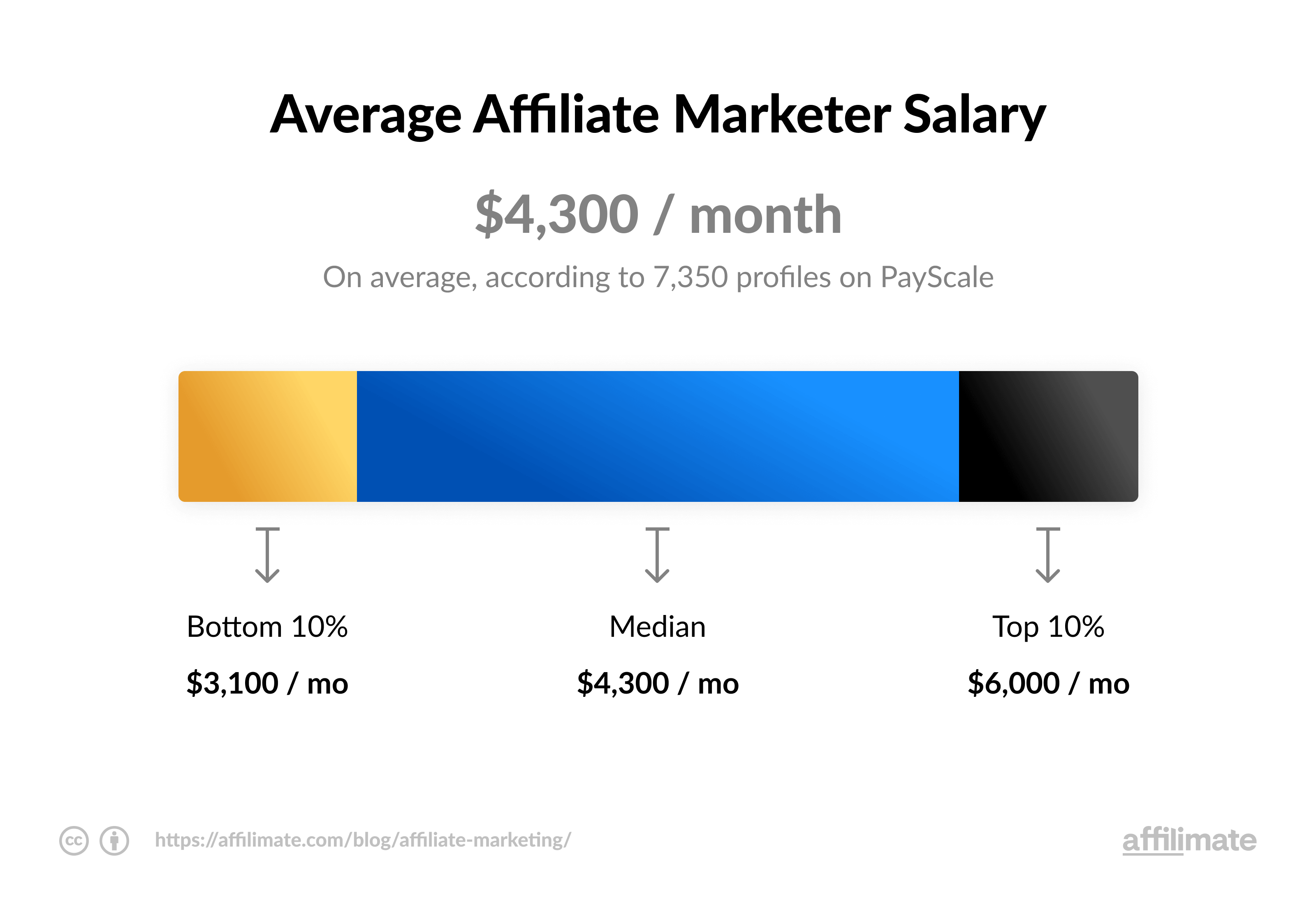
The top 1% of earners also make tens of thousands of dollars every month, if not hundreds of thousands. They frequently have dedicated teams, work as affiliate marketers full-time, and have years of experience.
However, you don’t have to push yourself to the limit if you want to create a successful company. Affiliate marketing has the advantage of initially augmenting your usual 9–5 income.
Replace it entirely if you have the time and resources to do so.
7 steps to get started with affiliate marketing
The biggest open secret in the industry is that your affiliate marketing income potential is largely dependent on the niche you choose. Specifically, the customers you hope to reach and the products they need. You must know what to look for in order to select a profitable niche for your affiliate marketing business.
The actions you need to start with are as follows:
Step 1. Choose a niche based on research
Rushing to catch the latest fads can lead to trouble when these trends end faster than they appear (fidget spinners, anyone?).
Doing niche research is the best thing you can do to make sure your affiliate business has high earning potential and will make money for years to come.
You’ll be able to study the competitive environment, establish a long-term affiliate marketing strategy, and plan your content as a consequence. You’ll also be able to find affiliate programmes that are available in your industry.
Below is a summary of the niche research process:
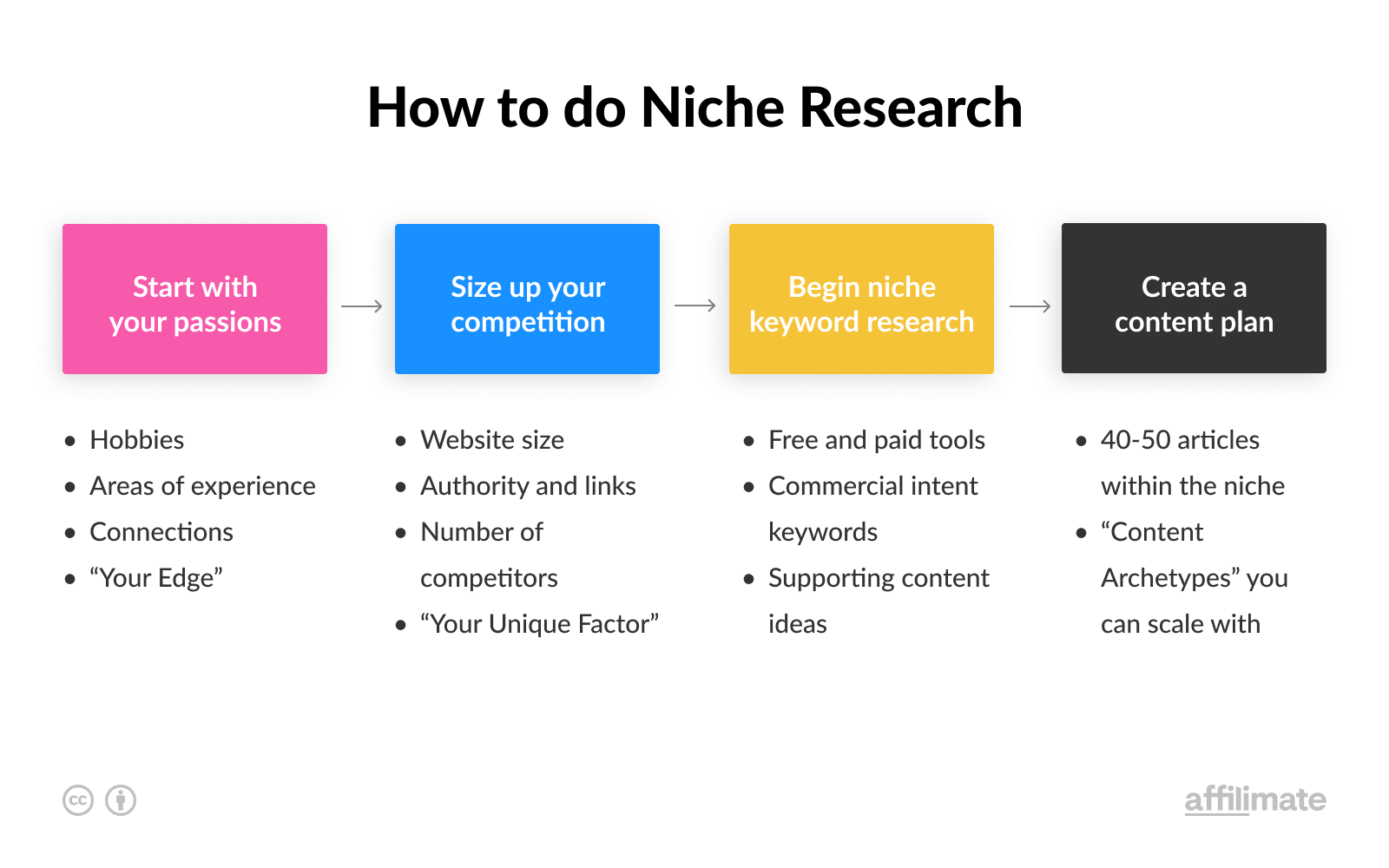
If you’re looking for niche ideas, there are plenty of free niche research tools that will help you get the ball rolling. Just quickly, here are three popular tools for niche research:
- Google Trends – Trending topics and searches, organized by geography
- Answer Socrates – Find out which questions people type into Google
- Exploding Topics – A Google Trends alternative with curated results
Learn About Affiliate Marketing 2022-23
Having said that, if you’re starting affiliate marketing on a tight budget or with no money at all, I advise focusing on a topic you’re passionate about. You won’t become frustrated with or hate your niche until you’ve written 50 or more articles on it.
Re More:- Game of Thrones: Tale of Crows has me completely enthralled and is an essential iPhone game for 2022
But having a topic you like isn’t enough; it also needs to be lucrative.
Again, tools like Google Trends are good for vetting niches that you discover and making sure they’re not just passing trends. In all likelihood, you’re going to want to choose an evergreen niche which generates income all year, every year.
Studying the competition is essential for figuring out how to enter the market.
One of the most lucrative affiliate niches is web hosting, therefore you might want to start a blog about it. However, for beginning bloggers, the tools and content required to compete may be out of their price range.
Look for markets with a moderate amount of competition, where there are a few well-known players, but where you can stand out, serve a smaller market, and expand later.
For instance, rather than focusing on “web hosting” for everyone, you might start with “salon website builder” and train specialists in the beauty sector. By creating a specialty, you may build a close-knit community for your company and potentially raise your Google ranking.
Further reading: Elon Musk says free employee lunches at Twitter HQ were costing more than $400
Step 2. Choose the right platform
With a niche in mind, it’s time to decide where to host your affiliate content and what type of content you want to create.
There are two main choices for affiliates starting out: a website or a YouTube channel.
YouTube can be an excellent place to grow an audience, build a brand, and promote affiliate products to an audience that trusts your recommendations.
But there are some downsides to starting with only a YouTube channel:
- Video takes longer to produce than written content. Which limits the amount of content you can create when starting your project.
- Videos are harder to outsource. Especially if you’re the face of the channel, it means you’ll need to be involved with every video.
- Harder to grow your email list. YouTube doesn’t have a built-in way to collect email subscribers. Yet email is one of the most effective channels for affiliate marketing.
- YouTube channels tend to make less affiliate money. There’s simply more friction to getting clicks on your affiliate links from a video compared to a well-optimized blog post.
Ultimately, it’s great to have both a website and YouTube. Embedding videos on an affiliate website is also an excellent way to boost conversion. But if you’re a total beginner, you’ll probably find it easier to start affiliate marketing with a blog.
WHEN IS YOUTUBE A BETTER CHOICE?
YouTube could be a better choice if you’re looking to get into an incredibly competitive area. For instance, suppose you wanted to promote credit cards or teach your audience about email marketing. Because video is a more challenging medium to master, there is less competition, allowing you to focus more on your personality to build connection and stand out.
Step 3. Pick profitable affiliate programs
Joining affiliate programmes is easy. Spreading oneself too thin is one of the most frequent errors affiliate marketing newcomers make.
Start by choosing a few affiliate programmes with respectable commissions, high conversion rates, and consistent demand.
The following three recommendations will help you select a reputable How to do affiliate marketing program:

First, assess earning potential
The range of payments offered by affiliate schemes varies substantially. Some programmes pay a couple of cents for each conversion. Others shell out several hundred dollars for only one lead.
Programs with lower payouts are often more appealing because they are simpler to join and advertise, but more sales are needed to generate the same amount of revenue.
The following three methods will help your affiliate math “work out”:
- This High volume and low commissions. This includes most Amazon partner websites. For Amazon, you need to generate $100,000 in revenue in order to earn $5,000 per month in 5% commissions. It will take 1,000 orders—at a median purchase size of $100—to generate $5,000. Typically, in order to succeed here, you need a lot of traffic.)
- Low volume, high commissions. For example, luxury affiliate programs (expensive watches or luxury fashion) and photography affiliate programs (expensive camera equipment). Both are more niche, but require fewer conversions to reach a revenue goal.
- High volume, high commissions (…and high competition). Financial affiliate programs (like credit cards and bank accounts), or SaaS affiliate programs (like web hosting and email marketing tools) are both good examples. These programs are so profitable, you may struggle to compete.
Check the cookie duration for the affiliate programme while you’re at it. Longer cookie lifespans (more than 30 days) provide you more chances to influence your audience’s purchasing patterns.
However, for consumers who have already completed their purchases, shorter cookie lives could be useful. Make sure your content is targeted at people who are farther along in the purchase process if you decide to work with programmes that have shorter cookie lifespan.
I’ll go into more depth about affiliate marketing’s consideration of the buyer’s path later.
Second, assess the competition
It could be healthy to have some competition. If others in your field are succeeding, you will probably too. You may find competitors by simply searching Google for the kinds of search terms that your website should rank for.
Read More:- High Evolutionary Villain Marvel’s Already Abused 1 Guardians Hero
Find out the affiliate programmes your competitors are heavily promoting on those websites next. Learn how to sign up for the programme and the conditions they offer.
This is one of the best ways to evaluate affiliate programmes if your competitors are more advanced than you are.
BEWARE A LACK OF COMPETITION
Although having no competitors could seem advantageous, it typically indicates that the niche is unprofitable. Worse worse, they may have previously tried, fallen short, and given up. But if it’s obvious that others are succeeding in a particular niche, that’s a sign that you can too.
Third, evaluate brand alignment and reputation
You are creating your own brand and image while promoting the products and services of other businesses. Think carefully about who you choose to stand for. Working with organisations that undermine your brand results in audience cynicism and long-term damage to your brand.
Check the brand you are marketing’s conversion probability as well. Examining their sales pages, responsive design, and other online reviews are required for this. Think about the aspects that you, as a buyer, would consider before buying the products.
Now that you’ve selected a few affiliate networks in your extensively researched niche, it’s time to start creating content.
Step 4. Create optimized affiliate content
None of the previous steps matter if you don’t have high-quality content that converts.
Creating content for affiliate marketing is more than simply adding links to an existing blog post. You need to help your audience make a decision on a product or service, directly on your website, through strong copywriting and appealing design.
Some examples of high-converting affiliate marketing content include:
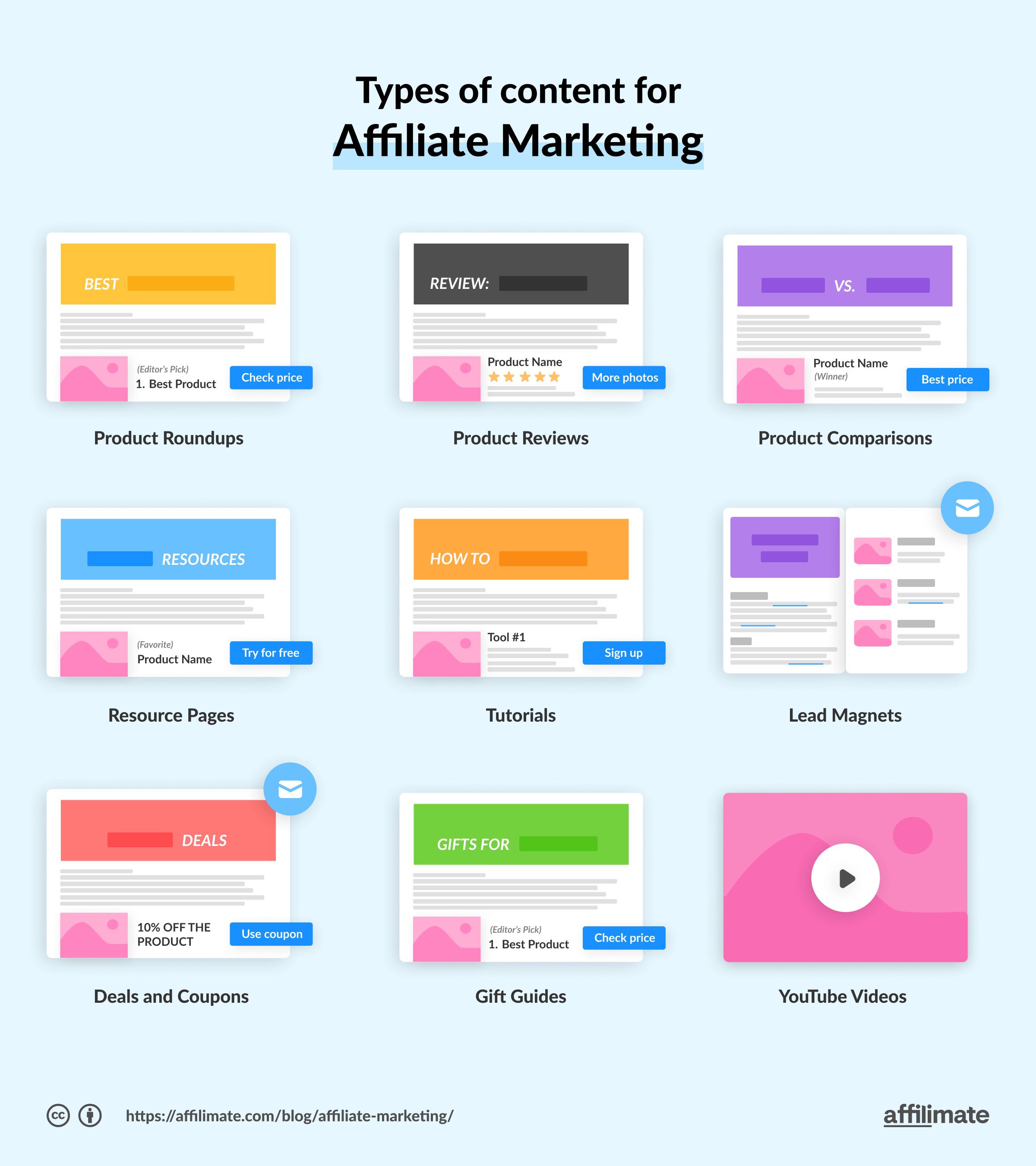
- Product reviews: Nearly 97% of consumers look at online reviews before making a purchase decision, so product reviews are a staple amongst affiliate marketers.
- Product roundups: Roundups based on a specific theme or category lead different readers to relevant products and diversify your revenue away from a single link.
- Product comparisons These are similar to product reviews but place similar products side-by-side to highlight pros and cons. Product comparisons are extremely helpful to orient audiences.
- Resource pages: Resource pages are compilations of your favourite tools and resources. Resource pages that focus on solving a problem for your audience won’t be the highest converting pages but will help to present you as an expert to your audience and gather all of your affiliate links in one place.
- Tutorials: Tutorials are an opportunity to highlight exactly how a product works in an easy step-by-step process. Customers are likely to trust and buy a product when they can see exactly how it will work for them.
- Ebooks: Topics don’t always fit into a nice blog post or or email. This is where ebooks come in. They give you an opportunity to do a deep dive into a topic. As a bonus, you can use the ebook as a lead magnet to build your email list.
Affiliate content also goes by other names, such as commerce content. But no matter what you call it, don’t forget to include an affiliate disclosure which informs your audience that you may earn a commission if they buy from your links.
Once you’ve chosen a content format, it’s time to optimize the page for conversion.
Conversion 101 for new affiliates
Here are some of the most effective ways to do it without having to use a lot of complicated plugins.
Placement of buttons is important for getting visitors to respond, whether your call to action is to register, subscribe, or learn more. With CTAs like “Read more reviews,” “Check the cost,” and “See more images,” buttons should be placed in a visible place.
An example of a product review with a prominent button above the browser’s fold is seen here:
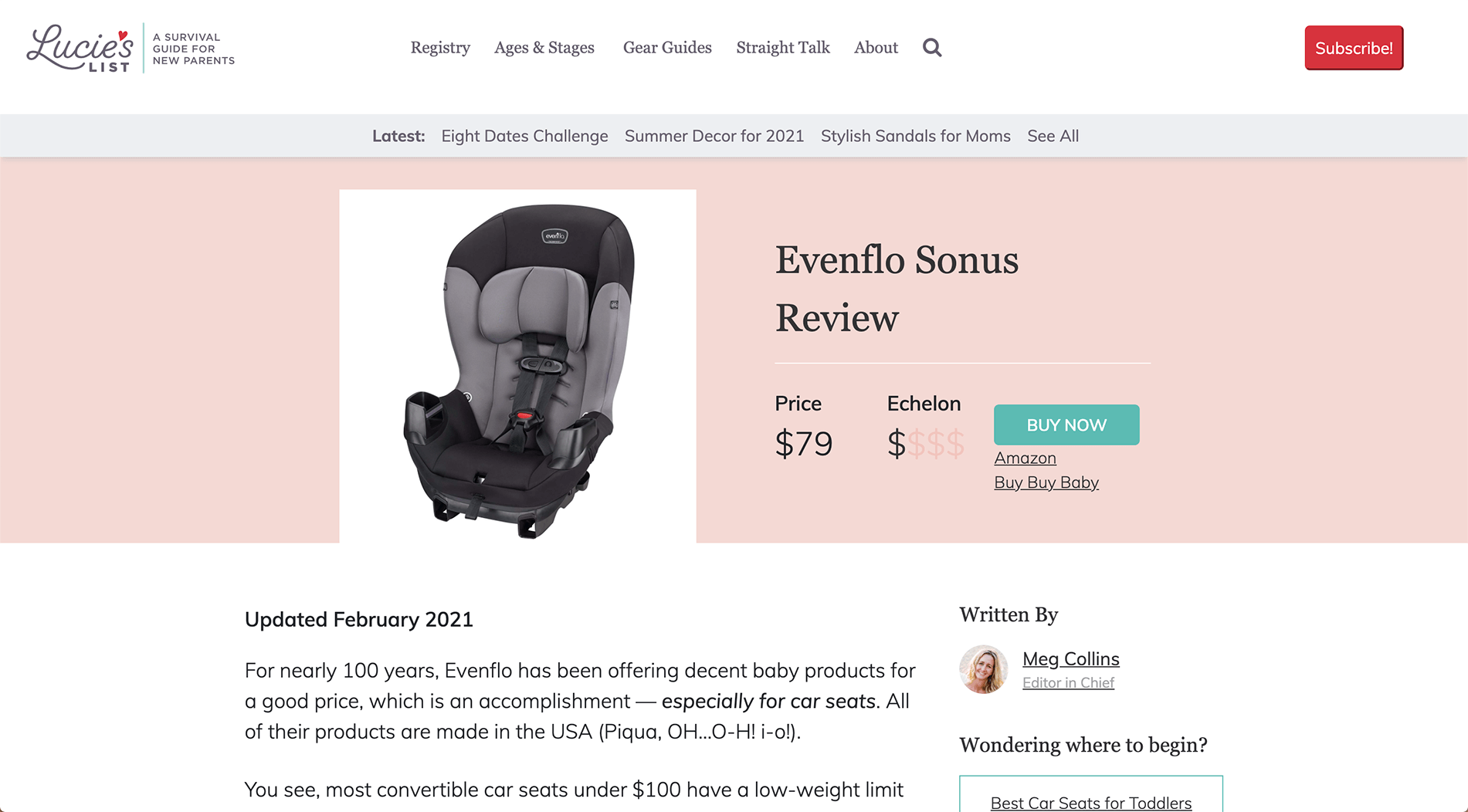
Callouts: Also called text boxes, these visually separate important information from the rest of the blog. You can use them for compelling quotes or statistics that influence your visitor’s decision in their buyer journey.
Here’s an example from Themeisle’s review of Elementor:

Both the number of instals and the positive reviews serve as social proof that the product is effective.
Visual summaries of information are equally as crucial as high-quality textual material. Examples include graphs, charts, and comparison tables. By integrating graphs and charts, you may provide users a quick summary of important facts.
Here is an illustration from a website that compares kids’ smart watches:
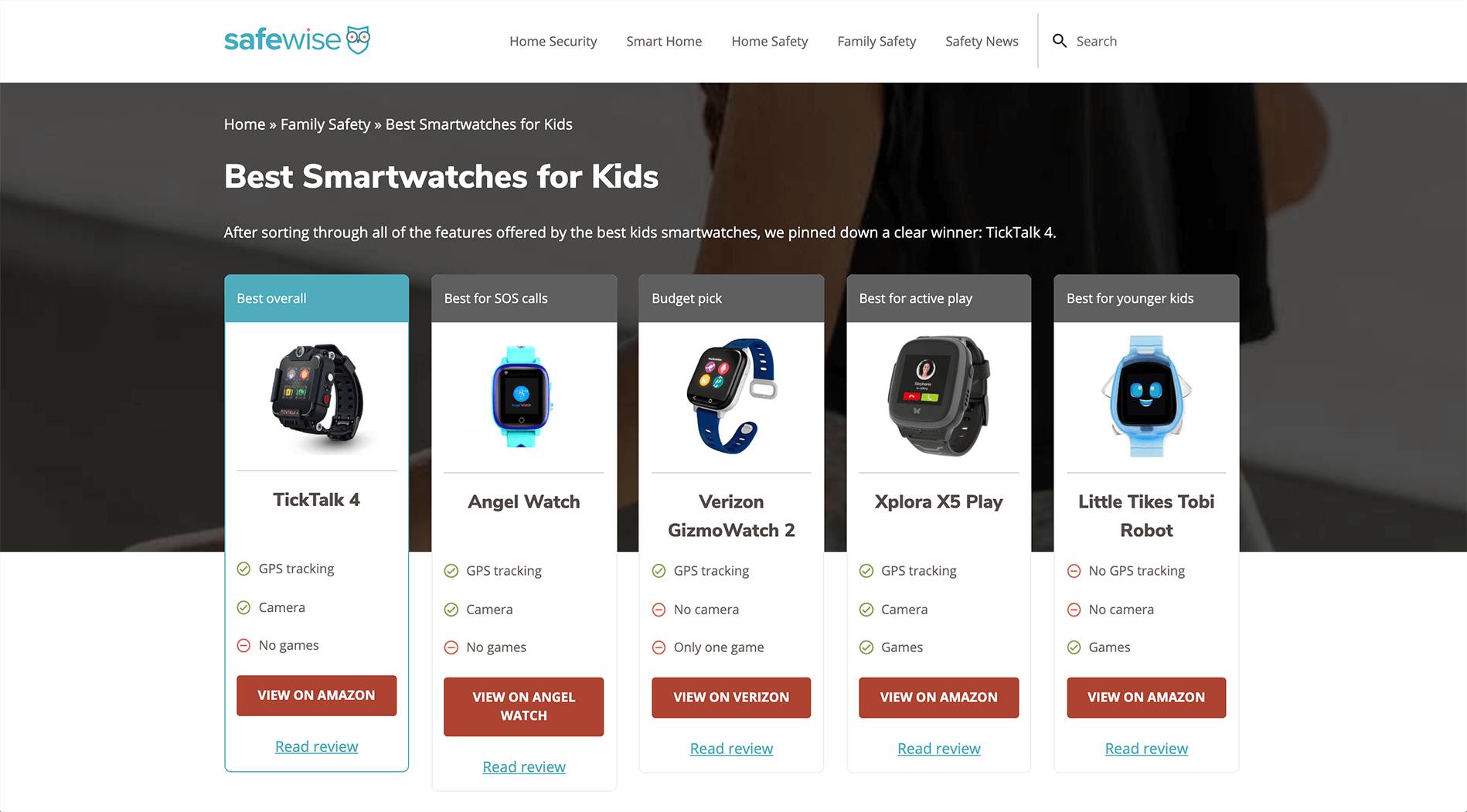
People frequently base their purchasing decisions on emotion. Readers are more likely to convert when you use images that support the emotion your writing is trying to convey. Even better if you can provide pictures of the outcomes a product has assisted you in obtaining.
For instance, the author of this cosmetics review displays how they used each product:

Banners: Banners may be eye-catching and stand out, but they also are easily ignored due to a “banner blindness” and people tend to ignore banners entirely. You can include them, but make sure to have plenty of tasteful text links and buttons — those will be your main conversion drivers.
Popups: Although controversy surrounds popups because they can be annoying, they are also highly effective at converting your readers. Each popup is an opportunity to recapture audience members through strategies like discount codes and limited time offers.
Step 5. Drive traffic to your affiliate site
Now it’s time to drive traffic to your carefully selected offer. This can be done through social media platforms, SEO blog posts, and email lists.
The key is you want to either reach people who are looking to buy, or capture their email address to educate and inform readers before prompting the purchase.
Here are some of the best free traffic sources for affiliate marketing:

Social media sites like Twitter, TikTok, Instagram, Pinterest, and Reddit are all great free traffic sources for affiliate marketing, but they do require some time and effort to make them work.
But the most successful affiliates also invest in growing traffic through SEO.
By targeting buyer intent keywords, you can reach visitors who are heading to Google right before making a purchase. Using this technique, it’s much easier to get clicks on your affiliate links and earn commissions than trying to sell to people who aren’t ready to buy.
Read More:- Record time In 2022, the gazebo design software market will be expanded by gazebos
Another free traffic source we can’t recommend enough is affiliate marketing through email.
The direct nature of emails means tailored messages are delivered straight to your prospects’ inbox. This helps them learn more about a product and moves them towards a buying decision.
Email works great for regular product curations, sharing time-sensitive deals, and reinforcing your top recommendations to your audience.
Step 6. Build a simple affiliate marketing funnel
An affiliate marketing funnel is a carefully laid out process that guides users from the start of their buyer journey to the point where they are repeat customers.
Funnels are critical if you need to take an audience who isn’t ready to buy (such as most visitors from Pinterest or other “inspiration”-based channels), and warm them up to your brand and offer.
By using a funnel, the reader sticks with you through all the stages of the buyer’s journey. Even if they joined you weeks or months before they’re ready to make a purchase.
Here’s how you can visualize the buyer’s journey:

The buyer’s journey consists of four main stages:
- Awareness: The prospect notices and identifies their problem
- Consideration: The prospect considers possible solutions to their problem
- Conversion: The prospect makes a purchase decision and thereby becomes a customer
- Loyalty: A positive customer experience leads to trust and repeat purchases
Here’s how to practically implement a simple funnel, so you can convert cold traffic into customers.
FUNNEL OR NO FUNNEL?
It’s possible to send customers directly to the affiliate website through single pieces of content, especially with low-ticket offers that have straightforward value propositions. Funnels are an especially suitable strategy for high-ticket affiliate programs that require a longer education period before customers are ready to buy.
Stage 1. Collect leads through email affiliate marketing
After a visitor lands on your website, it’s time to convert them to an email list using free offer opt-ins. This can be a downloadable PDF guide, email course, resource library, or other gated content.
Getting started with email might sound intimidating, but it’s an early investment you won’t regret.
Read our related post about affiliate marketing through emails for how to get started, step by step.
Further reading: Email Affiliate Marketing: How To Use Emails To Boost Your Affiliate Revenue
Stage 2. Send leads to affiliate landing pages
When a potential customer is on your email list, you have more influence over their purchase decision, giving you the opportunity to fill in the gaps and offer help as needed. You have the opportunity to now discuss facts pertinent to that part of the journey.
Reading emails from you that contain information about you, the results a product helped you reach, customer testimonials, lessons, and instructions may provide the prospect the confidence they need to make a purchase.
Once they’re ready, you may link to your affiliate landing page. These provide you still more chance to interact with your audience, encourage them to continue to the buying step, and build trust before they reach the advertiser’s sales page.
Stage 3. Optimize your funnel
What makes marketing funnels incredibly helpful is they show you where to adjust and improve your processes. With a funnel, you can pinpoint the exact stage where someone drops off the journey.
When you know that, tweak it to provide an improved process for the next person through the funnel.
Stage 4. Bag repeat sales by emailing your list regularly
Customers that have made their way through the funnel are still good prospects for other offers.
Your email list now gives you the opportunity to provide additional email content that will lead them through a new buyer’s journey and guide them through the funnel for a different product.
Further reading: How to Build a High-Converting Affiliate Marketing Funnel in 5 Steps
Step 7. Track and increase your affiliate revenue
Let’s talk about tracking now. Proper tracking is one of the most important components of successful affiliate marketing.
It’s the difference between going back and flicking a switch to turn on a light vs fumbling about in the dark looking for your keys. Your ability to identify which elements of your affiliate marketing strategy are successful and which ones are not will determine your capacity to make more money, faster, and with fewer pieces of content.
And the beginning of your affiliate website is the best time to set up a system that will expand with you. The two main ways that monitoring could help you develop your affiliate strategy are as follows:
First, get basic affiliate tracking in place
There are two types of affiliate tracking:
- Tracking a network does for you (attributing your sales and tellling you which products people bought through your links)
- Tracking you have to do for yourself (figuring out which pages, affiliate links, text and visual elements are converting).
To handle the second case, you can use SubID tracking. SubIDs are additional data that you attach to your affiliate link, which ultimately gets recorded next to every conversion that results from that exact link.
Typically, a SubID is a query parameter you can add onto existing affiliate links. Here’s how SubIDs fit into your affiliate links:

If you’re familiar with Google Analytics, SubIDs work similarly to the utm_campaign parameter.
For more information on SubIDs, read our guide to SubID tracking for affiliates. It’s a little technical, but you’ll be grateful you set it up right from the beginning.
You can also forego doing this manually, and use an affiliate marketing tool like Affilimate to fully automate this process.
Then, start to run some tests
The first step after setting up tracking is to decide which blog post you wish to test. High traffic posts, posts with fresh traffic, and posts with high intent but low RPM should all be taken into account (revenue per thousand visitors).
Read More:- McDonald’s के ‘Adult Happy मील’ खिलौने eBay पर $300,000 तक सूचीबद्ध हैं
Once you’ve decided on a blog article, try it out to see how it performs and where it may be improved. You may conduct the following tests on your affiliate material using the principles below:
- Adding comparison tables
- Switching the text on call-to-action buttons
- Inserting links to alternative affiliate products
- Decluttering by removing links that aren’t yielding any conversions
- Testing different link text
By employing distinct SubIDs, you can determine which approaches are converting. You should evaluate the amount of income the piece of content is making in relation to the audience size in addition to whether the additional parts are driving more clicks and sales.
Again, instead of manually piecing data from various sources into complex spreadsheets, you can automate this process using a tool like ours:

Running successful tests is also one of the most effective ways to invest in and flip websites, once you’ve developed a feel for it.
Get these two strategies right from the beginning, and you’re several steps ahead of most affiliate marketers today.
Affiliate marketing mistakes to avoid
Once you nail the broad overview of affiliate marketing, make sure you don’t slip up on the details.
There are several small, seemingly unimportant decisions that add up to make or break your success. Here are some of the most common affiliate marketing mistakes to avoid:
- Making your intro too long. Whether you’re writing content or producing videos, you have seconds to capture your audience’s attention. Keep your intros short and sweet and make sure you’re making it clear what they’ll gain by sticking with you.
- Targeting the wrong part of the buying cycle. If your audience doesn’t understand the offer, they won’t convert, no matter how hard you try to sell. Your content should match where your audience is in the buying cycle, providing education where needed.
- Not including a clear top recommendation. Product roundups and comparisons are high-converting content, but consumers are looking for a clear recommendation. Make it easy for them to make a decision by letting them know your preference.
- Not suggesting and linking to alternative affiliate products. Consumers are growing more and more skeptical. Pushing a product as the cure to everything will raise red flags. Instead, make honest evaluations and acknowledge the benefits of alternatives. Even better is if you can capture revenue by using affiliate links for competing products.
- Not tracking affiliate metrics. The most successful affiliate marketers treat their marketing as what it is — a business. Tracking allows for revenue optimization based on data-driven insights, rather than gut instinct or guessing.
Avoid these mistakes, and you’ll be doing better than 90% of new affiliate marketers who lose their readers before the very first click.
What you need to know about affiliate marketing in 2022
Consumer behavior has changed dramatically in the last year. Affiliate marketing has to keep pace with new technical and legal requirements in order to stay relevant, accurate, and privacy compliant.
Starting is the hardest step, but don’t let your efforts go to waste. Keep these affiliate marketing trends in mind to build a sustainable business model and future-proof your revenue.
1. Brands want partners, not just affiliates
The win-win business model has a lot of potential for both brands and publishers even if affiliate marketing hasn’t always had the best reputation. This move is reflected in a rebrand from “affiliate marketing” to “partnership marketing.”
Brands and organisations are moving their attention away from quantity of interactions and toward quality connections. Thousands of content creators and influencers used to promote brands and their goods in the past. The top candidates are now chosen with more discriminating in order to represent and progress them.
Brands will favour those that can promote their image while establishing a genuine connection with their audience. Brands are looking for content producers that will rely on the audience’s devotion to portray them in an honest and moral way.
You can demonstrate this to brands with engagement metrics, such as an email list with solid click-through rates or a social media account with an active comments section. This also gives you leverage for negotiating higher commissions.
2. Diversification is more important than ever
Success in the affiliate space is seldom tied to a single income source. Robust income as an affiliate means diversifying your streams and being a part of a variety of programs. If you stick to only one program, rate cuts and program adjustments are a massive blow to your expected earnings.
This is exactly what happened to Amazon affiliates both during the early stages of the pandemic and again in early 2021.

Programs that rarely engage with their affiliates on a one-to-one basis also offer very little recourse for affiliates when things go wrong. Although programs like Amazon can be convenient and lucrative, introducing alternatives guard against dramatic loss of income as well as add to your current earning potential.
3. Multi-channel is your moat
Results obtained through a single platform are trumped by a multi-channel strategy.
You may get the best of both worlds by combining “owned” platforms like your website, blog, and email list with “rented” platforms like Instagram, YouTube, and Pinterest.
- Global AI Show and Global Blockchain Show Premier in Dubai helobaba.com
- Central Banks Kept Purchasing Gold in February; China Continues Gold Run helobaba.com
- Binance Updates Fiat Liquidity Provider Program to Include MXN and CZK Markets helobaba.com
- China’s Largest Fund Managers Eye Spot Bitcoin ETFs in Hong Kong’s Financial Markets helobaba.com
- From Kangana Ranaut to Madhuri Dixit: Nauvari sari inspiration for Gudi Padwa helobaba.com
Social networking is crucial for growing your following and reaching new people. The second most used search engine worldwide is YouTube alone. Successful social media content directs your target market to your “owned” internet property, mainly your website.
As an affiliate marketer, you must reach out to and establish a relationship with your target audience through a variety of channels in order to generate sales and return customers.
Ready to take action?
Future-proofing your affiliate marketing business heavily relies on diversification and multi-channel strategies.
In order to maximise their business, the majority of successful affiliates wind up juggling various logins and platforms.
You may use Affilimate to access a single hub for all information pertaining to your affiliate programmes rather than logging into what seems like a million complicated dashboards.

The Affilimate dashboard also gives you an at-a-glance understanding of how your affiliate marketing content is performing. Keep track of your revenue, identify top-performing content and gain insights into optimization all in one place.

Check out Affiliate’s Free 15-Day Trial to bring all your affiliate networks into a single dashboard and attribute your conversions back to content on your website.
Or, sign up for our email list below for free-content to help you level up your site and grow your affiliate revenue from scratch.









